Designing Rovers for the Moon’s Extreme Environment
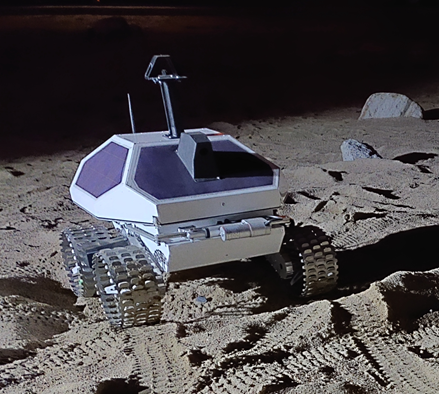
Lunar rover in its testing environment, created to mimic conditions on the Moon.

Lunar rover in its testing environment, created to mimic conditions on the Moon.
How does this align with my curriculum?
Learn about the extreme environment on the Moon and the challenges this poses for designing lunar rovers.
Looking at the Moon from our home on Earth, it doesn’t seem too scary. Just a patchy grey sphere in the sky. Would it surprise you to know that the lunar surface is full of dangers for humans and machines alike? Exploring the Moon is serious business.
Lunar Rovers

Lunar rover in its testing environment (Source: Canadensys Aerospace Corporation (Canadensys). Used with permission.
Image - Text Version
Shown is a colour photograph of the Canadensys lunar rover in its testing environment. It is turned at about 45 degrees.
The body of the micro rover resembles a turtle with its domed octagonal shape. The body of the rover is mostly white with grey hexagonal shaped solar panels attached on a slant to its sides. A small antenna can be seen from the top rear portion of the rover. A small camera is mounted to a rod and positioned at the top centre of the rover. Small wheels are attached to the bottom of the rover, the open metal design resembles cheese graters. Other smaller instruments are mounted to the front of the rover.
The lunar rover has left wheel tracks in the grey simulated moon soil. There are two rocks in the upper right corner of the image. In the background, darkness spreads beyond the rover.
Darkness
From Earth, we always see the same face of the Moon. This is because the Moon is spinning on its axis at the same speed that it is going around Earth. We say that it is in synchronous rotation with the Earth.
Moon Orbits Earth Animation (2022) by SciTech Daily (4:53 min.)
Some areas of the Moon are always either light or dark. These are at the poles of the moon. Some mountains in these areas are always in sunlight. Deeper craters in these areas are always dark. We call these areas permanently shadowed regions or PSRs. These craters are dark because the Sun is very low relative to the horizon.
Darkness is a real challenge for rovers. This is because the main source of power for a rover are solar panels. Without power, a rover cannot move, use its science instruments, turn on its headlights or communicate with Earth.
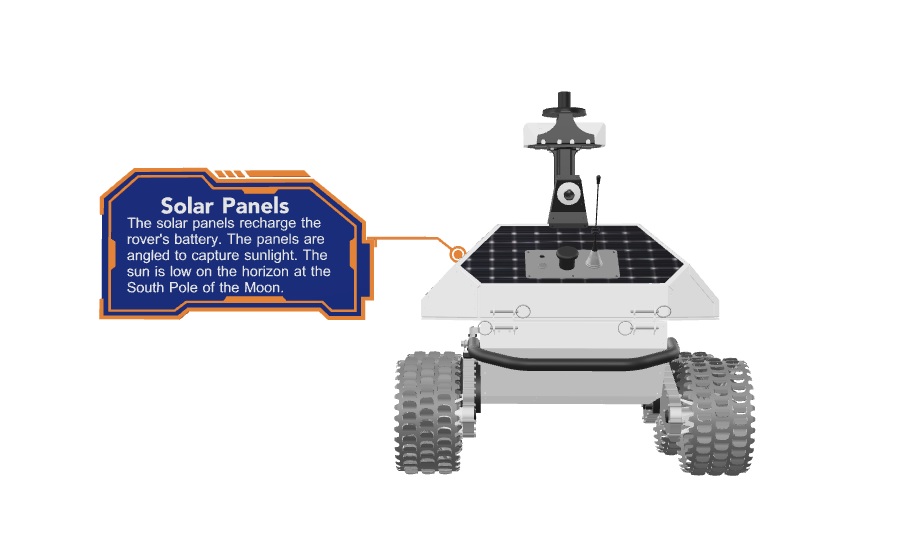
View of the solar panels on a rover (Source: Lunar Rover Research Challenge by Let’s Talk Science powered by actuality),
Image - Text Version
Shown is a colour illustration of the Canadensys lunar rover on a white background.
A blue and orange call-out box points to the left hexagonal solar panel on the rover. The white text on it explains that the solar panels recharge the rover's battery. The panels are angled to capture sunlight. The sun is low on the horizon at the South Pole of the Moon.
Its features are the same as the previous image, however, the rover is facing straight into the camera in this image.
Solar panels need to get to the Moon undamaged. This can be tough! Solar panels are very breakable and launches are very shaky! A hard landing on the Moon could also cause the panels to break.
For a rover to survive darkness, it must spend time in a sunny location. This lets the battery charge enough to run its heaters.
Rovers may also recharge using a nearby lunar lander. The lander acts like a homebase for the rovers while on the Moon. The rover could use docking software to find the lander. Once nearby, the rover could use wireless charging to charge itself.
The company WiBotic was chosen by NASA to deliver this kind of wireless charging for upcoming lunar missions.
Extreme Cold
There is an extreme difference in temperature between day and night on the Moon. During the day, the temperature rises to about 127 degrees Celsius. During the night, It can dip down to as low as - 173 degrees Celsius. It can get even colder inside the craters!

Artist’s image of the LRO (Source: public domain via NASA).
Image - Text Version
Shown is a colour illustration of the Lunar Reconnaissance Orbiter (LRO), a NASA robotic spacecraft.
The LRO can be seen in the foreground, orbiting above the surface of a large Moon. A smaller Earth can be seen, some distance away, and seems to half disappear into the darkness of space.
The LRO resembles a metallic rectangular prism with a Miniature Radio Frequency radar dish mounted high on a metal post. Its large solar panel is positioned at a slant, on the opposite side of the orbiter.
Did you know?
The coldest temperatures in the Solar System have been recorded at the Moon’s poles. Scientists have so far only studied these areas using remote sensing instruments.
To explore craters and PSRs, rovers will have to survive these extreme cold temperatures. How will they do this?
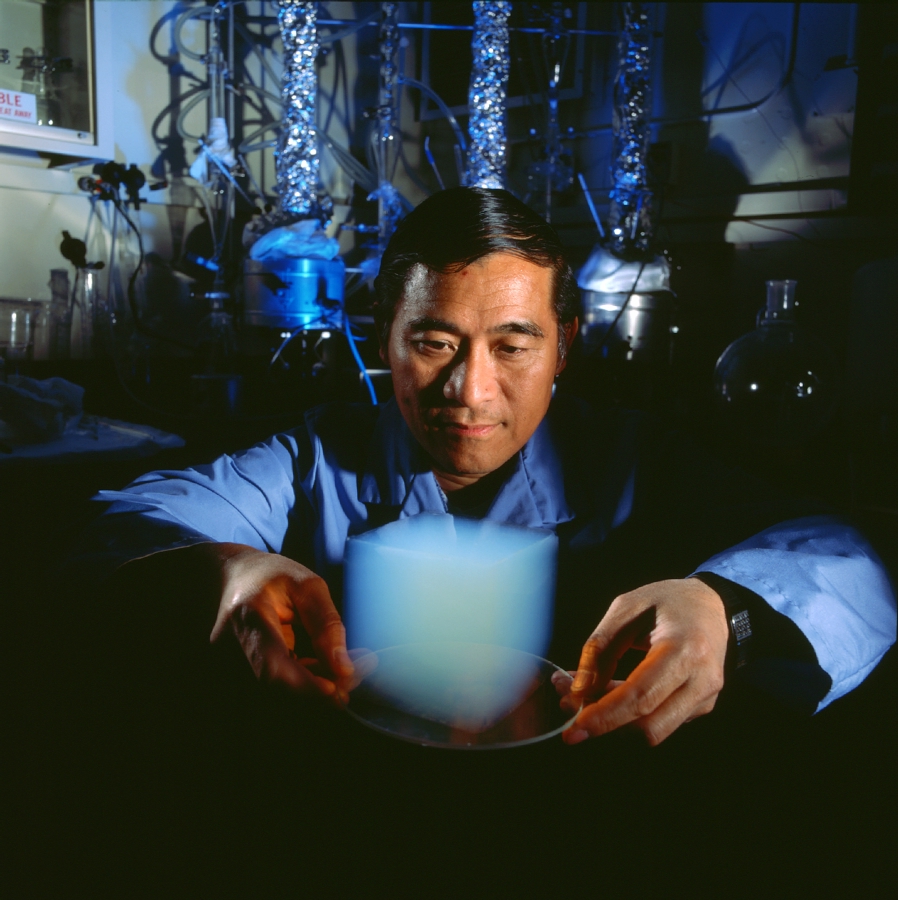
Scientist Peter Tsou holding a cube made of Aerogel (Source: NASA/JPL-Caltech [public domain] via Wikimedia Commons).
Image - Text Version
Shown is a colour photograph of a JPL scientist holding a translucent cube of aerogel on a glass plate, with arms bent at the elbows. They are inside a darkened laboratory.
Peter Tsou has brown skin, black hair and is wearing a blue lab coat. Below the arms, the image is completely black.
Laboratory equipment can be seen in the background, such as flasks, tubing, and pipes wrapped in foil.
Temperature Control
Rovers also have temperature control systems. This includes heaters. A thermostat on the heater can automatically switch the heater on and off. The heat rejection system uses a pump and tubing to release heat out into space. This works a lot like the air conditioning (AC) system in a car
Cosmic Radiation
In space there are lots of high-energy particles flying around. We call these particles cosmic radiation, or cosmic rays for short. These particles are very dangerous for people and equipment in space.
Earth’s magnetic field and atmosphere protect us from the impact of these particles. The Moon, on the other hand, does not have this same protection. The Moon does not have an atmosphere and its magnetic field is very weak. This means that it has little to no shielding from radiation.
Astronauts on the surface of the Moon would face between 200 and 1 000 times more radiation than on Earth. That is about two and a half times the radiation level on the International Space Station (ISS). High levels of radiation can lead to cancer and other illnesses.
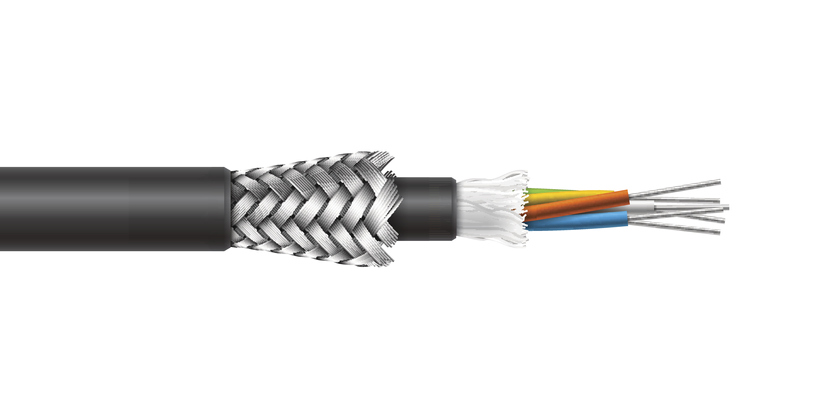
Example of a shielded wire (Source: vinap via iStockphoto).
Image - Text Version
Shown is a colour illustration of a shielded cable placed horizontally.
A black plastic jacket covers the outermost layer of this cable. Below that is a braided, spiralling wire shield. Underneath that layer is a white insulating material, with different coloured exposed wires extending out on the far right.
Did you know?
Hardening is the term for processes or materials used to protect electronics from radiation.
Challenging Terrain
From Earth, the ground on the Moon seems pretty flat and smooth. It is far from that! In some places it is flat, but in others there are steep rocky landforms and deep craters.
To explore these areas, rovers need to be able to climb and not get themselves stuck!
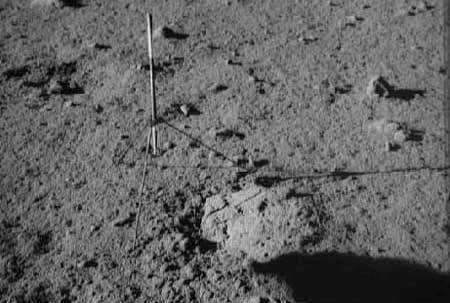
Moon surface image taken during the Apollo 12 mission in 1969 (Source: NASA via Wikimedia Commons).
Image - Text Version
Shown is a zoomed in black and white image of the Moon's surface.
The lunar surface looks grainy, greyish, and sprinkled with tiny dimpled holes. There is a stick-like marker, held up by a thin wire tripod, seen in the centre left of this image. A few small rocks scatter over the surface. A small dark shadow of irregular shape appears at the bottom right corner.
Juno rover testing (2020) by the Canadian Space Agency (1:32 min.)
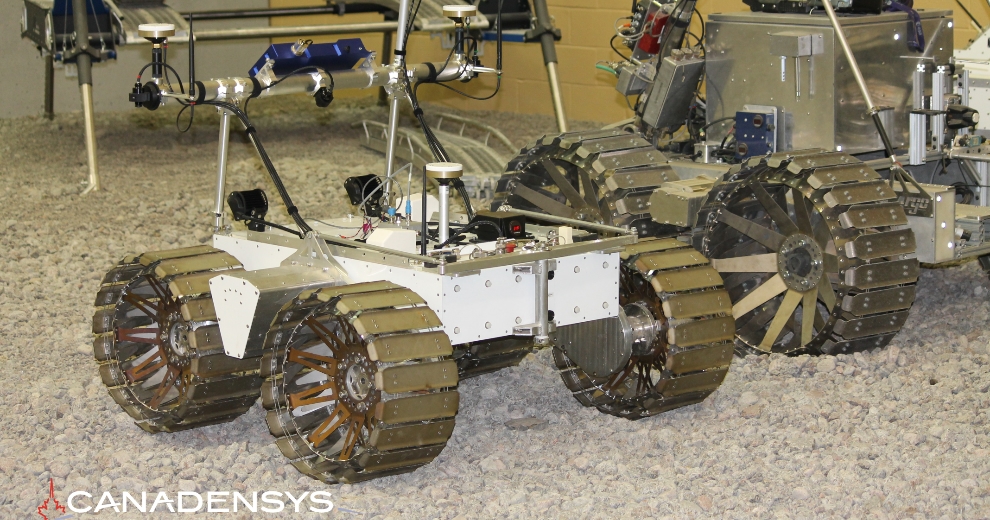
Canadensys rover wheels delivered to the Canadian Space Agency (Source: Canadensys Aerospace. Used with permission).
Image - Text Version
Shown are two rovers parked side-by-side on a gravel surface.
The rovers have similar wheel designs, metal plates mounted flat around the circumference of each wheel. The rover in the foreground has an open design with metal bars mounted on the vehicle. The other rover's instruments are enclosed inside a metal cover, with a few instruments mounted on the outside.
An additional metal frame can be seen in the background.
DuAxel: A NASA Prototype Rover to Explore the Toughest Terrain (2:43 min) by NASA JPL (2020).
Image - Text Version
Shown is a colour video recording of DuAxel, a flexible rover that has both ability to travel long distances and rappel down hard-to-reach areas of scientific interest. Composed of two axel robots, DuAxel is designed to explore crater walls, pits, scarps, vents and other extreme terrain on the moon, Mars and beyond.
DuAxel can be seen in a field test, driving across the red, sandy soil in the Mojave Desert in California. DuAxel anchors and deplores axel (two-wheeled rear section of the vehicle). Axel explores steep terrain on two wheels while being tethered to DuAxel.
Did you know?
On Earth, air-filled rubber tires are very common, but they would not work on the Moon. The extreme cold of the Moon would make the rubber so hard that it would shatter like glass!
Dealing with Dust
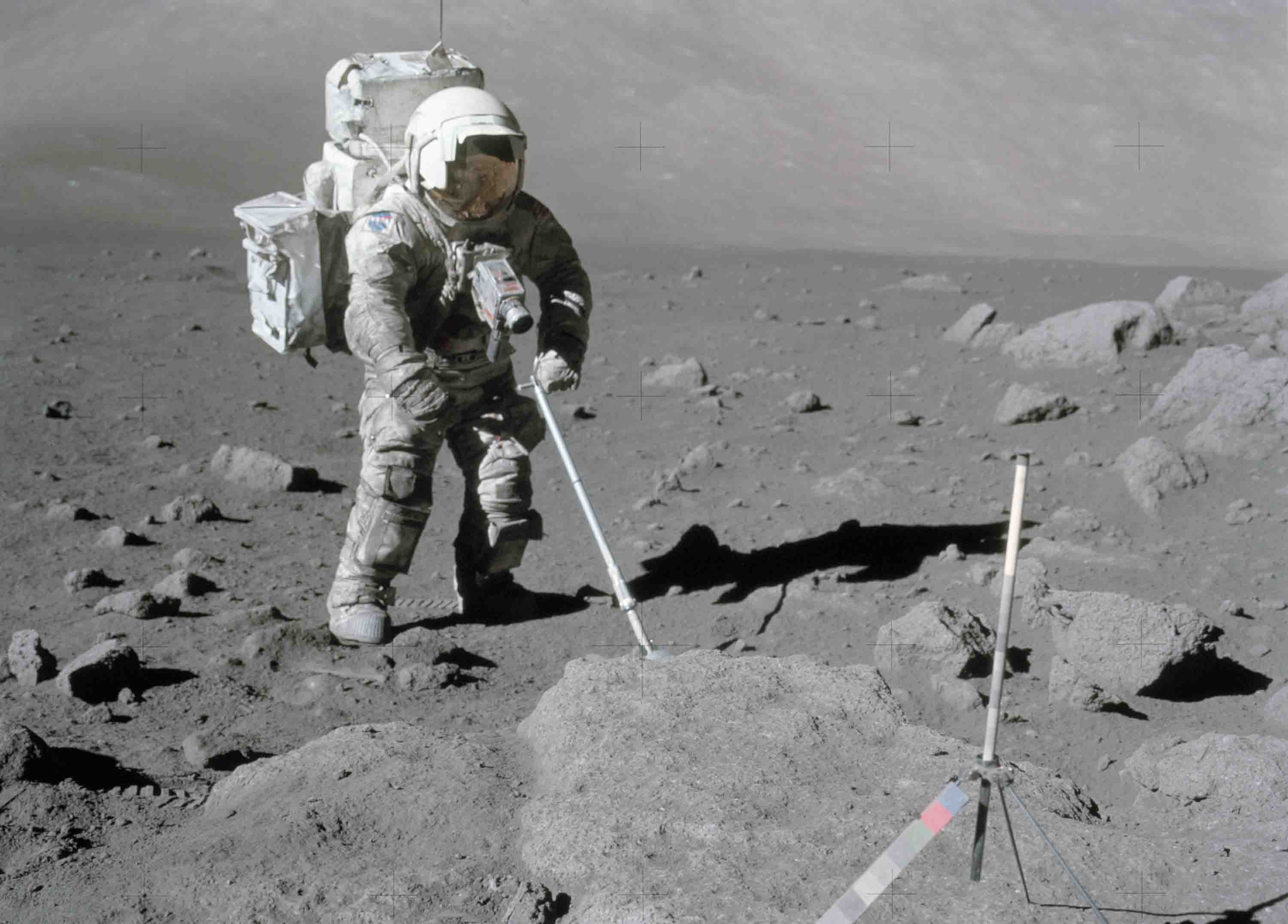
Scientist-astronaut Harrison Schmitt uses a sampling tool to scoop lunar samples during the Apollo 17 mission (Source: NASA).
Image - Text Version
Shown is a black and white photograph of a person dressed in a space suit, extending a rod-like tool into the ground on the Moon.
In the foreground are some large jagged rocks, and a stick-like marker, held up by a thin wire tripod appears on the lower right.
The person is wearing a white suit, helmet and gloves with a large, white backpack. Their dark shadow on the ground bends sharply to the right. More jagged rocks are spread out in an irregular pattern on the ground. The horizon is grey and appears smooth.
Lunar Rover Vehicle on Moon - 1969 (2022) from Science & Technology (4:25)
Image - Text Version
Shown is a colour video recording of the Lunar Roving Vehicle (LRV) during one of the last of the Apollo missions between 1971-1972. The LRV also known as the moon buggy, is a battery-powered four-wheeled rover.
The vehicle has an open air design, one astronaut in a white space suit is driving the vehicle over the bumpy, grey terrain of the lunar soil. As the wheels move over each bump, a plume of dust is kicked up into the air.
Beyond the horizon, the sky is a dark black.
A lot of work has been going into dealing with dust on astronaut spacesuits. Some of the technology might also work for rovers. This includes creating electrical changes to repel dust and applying a dust-resistant coating.
From Models to the Real Thing
In November 2022, Canadensys Aerospace Corporation (Canadensys) and its partners were selected to build the first Canadian lunar rover and its scientific instruments. This small rover will play an important role in the search for water ice on the Moon.

Image source: Canadensys Aerospace Corporation (Canadensys) via Let’s Talk Science Lunar Rover Research Challenge.
Image - Text Version
Shown is a colour photograph of the Canadensys lunar rover in its indoor testing environment.
The rover is in an environment which simulates the darkness of a lunar night. The white, dome-shaped rover has yellow headlights shining to an area just in front of it. Its jagged metal wheels have created many tracks through the grey, sandy soil. The micro rover is angled 45 degrees to the left. Deep tracks cover a low grey hill behind the rover, and beyond that, darkness.
This is a very exciting time for Canadian space technologies. Designing a lunar rover comes with many obstacles and challenges. But the information they will someday provide will be key to helping prepare for humans to live and work on the Moon.
Learn More
Tidal Locking | Why Do We Only See One Side of the Moon? (2015)
Video from MinuteEarth explains the Moon’s rotation and why we see one side of the Moon.
NASA Glenn's Shape Memory Alloy Spring Tire Animation (2017)
Video from NASA Glenn Research Centre shows how a shape memory alloy tire moves over a boulder.
Careers in Materials Science and Engineering (2015)
Video from Advanced Metallic System CDT showcases the work of a materials engineer and relates some space examples.
Careers linked to Space Exploration - People behind the 2016 Mars Sample Return
From geology to robotics engineering: discover how many different careers are related to space exploration.
References
Boyle, R. (2020, Oct. 22) Can a Moon base be safe for Astronauts? Scientific American
Bridgestone (2019, April 11) Bridgestone Lunar Rover Tires Support International Space Exploration Mission
Canadian Space Agency (CSA) (2022, Nov. 16) First Canadian Rover to Explore the Moon
Jet Propulsion Laboratory (2021, Nov. 4) A CADRE of mini-rovers navigates the lunar terrain of SLOPE
Jones, A, Barry, C., Vogel, T. (n.d.) Overview: Inside and Out NASA Science Earth’s Moon
Keller, J. (2021, June 28) The evolving world of radiation-hardened electronics for space Military Aerospace
NASA JPL California Institute of Technology (2020, Oct. 13) This Transforming Rover Can Explore the Toughest Terrain
NASA (2022, Jan 6) Artemis Moon Rover’s Wheels are Ready to Roll
NASA Mars Exploration Rovers (n.d.) The Rover’s Temperature Controls
Tabor, A. (2018, Aug. 20) Ice Confirmed at the Moon NASA
Taylor, D.A. (2021, July 16) Solar-Powered Moon Rovers will Help Scientists Seek Lunar Ice Astronomy
Tonn, S. (2018, Dec. 7) How do we Build Electronic Materials that can Survive Radiation? Stanford Engineering